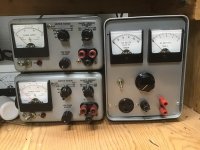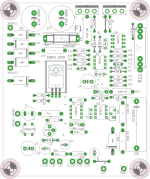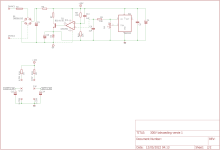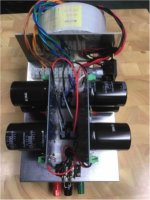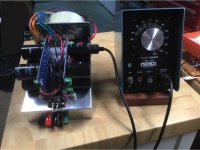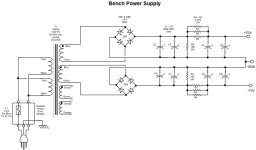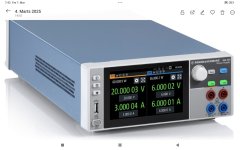Hi Carl,
The built in metering frees up my meters for other duties. It's always useful to know how much current you're drawing. I really like knowing my set voltage is actually what the circuit is receiving. I really love not having to move meters around and connect them, I just look at the power supply and it tells me.
The E36312A has four wire outputs in the rear in case you need to guarantee your set voltage is right at the UUT terminals, having dynamic correction. The trend display is also extremely useful at times. I think this is a case of when you have it available and use it, you realise how nice it is. Remember when we joked about power windows in a car? (I did).
The built in metering frees up my meters for other duties. It's always useful to know how much current you're drawing. I really like knowing my set voltage is actually what the circuit is receiving. I really love not having to move meters around and connect them, I just look at the power supply and it tells me.
The E36312A has four wire outputs in the rear in case you need to guarantee your set voltage is right at the UUT terminals, having dynamic correction. The trend display is also extremely useful at times. I think this is a case of when you have it available and use it, you realise how nice it is. Remember when we joked about power windows in a car? (I did).
Hello Carlp,
Used HP gear is usually good value. I bought mine 20 years ago, and they are in constant use. When I need more power, I made my own bench power supply as described in my DiyAudio post titled DIY Bench Power Supply.
Also many years ago, I made a variable AC source, nothing more than a 2 Amp Staco variable transformer, and a couple of meters. That variable transformer is quite expensive today ($200) but you can probably find a used one for a lot less. I do not power up any unknown device without using it. Bring up the voltage very slowly, watching the ammeter closely, any serious shorts will be obvious before any damage is done.
Cheers,
ceulrich
Used HP gear is usually good value. I bought mine 20 years ago, and they are in constant use. When I need more power, I made my own bench power supply as described in my DiyAudio post titled DIY Bench Power Supply.
Also many years ago, I made a variable AC source, nothing more than a 2 Amp Staco variable transformer, and a couple of meters. That variable transformer is quite expensive today ($200) but you can probably find a used one for a lot less. I do not power up any unknown device without using it. Bring up the voltage very slowly, watching the ammeter closely, any serious shorts will be obvious before any damage is done.
Cheers,
ceulrich
Attachments
Heres the Eagle files for a 0-300V 0-200mA lab power supply i did a while back. It needs improvement, i would replace the REF02 with LM329. And add source resistors for the mosfets so they share the load more evenly.
The DN2540 behind the current sense resistor is to keep the mosfets in conduction. The original design had another low current transformer winding for a BJT current source.
Cheers,
V4LVE
The DN2540 behind the current sense resistor is to keep the mosfets in conduction. The original design had another low current transformer winding for a BJT current source.
Cheers,
V4LVE
Attachments
Hi V4LVE,
Why not use a resistor instead of a CCS to load the mosfet output stage? It doesn't have to be a constant current. Also, normally you would have gate protection zener diodes as well. Otherwise not a bad little regulator.
I think the OP wanted a "mid voltage", bipolar higher current supply though.
Why not use a resistor instead of a CCS to load the mosfet output stage? It doesn't have to be a constant current. Also, normally you would have gate protection zener diodes as well. Otherwise not a bad little regulator.
I think the OP wanted a "mid voltage", bipolar higher current supply though.
Carlp,
here are two simple but very effective lab supply schematics :
https://www.diyaudio.com/community/threads/lab-supply-on-a-shoestring.227538/
and with a 723, a smart implémentation able to goes down close to 0V :
https://hobbylad.wordpress.com/2013/09/14/part-1-bench-0-30v-0-1a2-psu-regulator-pcb/
the third one is a bit more complex :
https://www.diyaudio.com/community/threads/mini-lab-supply.272987/
here are two simple but very effective lab supply schematics :
https://www.diyaudio.com/community/threads/lab-supply-on-a-shoestring.227538/
and with a 723, a smart implémentation able to goes down close to 0V :
https://hobbylad.wordpress.com/2013/09/14/part-1-bench-0-30v-0-1a2-psu-regulator-pcb/
the third one is a bit more complex :
https://www.diyaudio.com/community/threads/mini-lab-supply.272987/
Last edited:
Hello Carlp, just got the e-mail about new posts to this thread, not sure why I missed your 07-04 post. I will just repost the basics again.
I thought I would just build an open frame unregulated power supply, similar to what would actually be used in a completed amplifier, and power it from a 4.5 amp Variac I have. With that combination I could power up slowly, for testing, at any voltage up to the maximum of the unregulated supply. The 5 amp requirement implies using a transformer in the 300 - 400VA range. I selected 300VA because a model with two 50V secondary’s was available at the time from AnTek. I used the Universal PSU boards from the diy Audio Store, a pair of bridge rectifiers and a total of 27,200 microfarad of capacitance per rail. Total cost was $162.00. If one needed to buy the Variac also, they are available for around 50 – 60 dollars. Pictures and the schematic are attached.
Remember, it is open frame, so you have to be careful. I keep mine a couple of feet away from my work area. Of course you could also enclose it and put volt and amp meters on it.
Cheers,
ceulrich
I thought I would just build an open frame unregulated power supply, similar to what would actually be used in a completed amplifier, and power it from a 4.5 amp Variac I have. With that combination I could power up slowly, for testing, at any voltage up to the maximum of the unregulated supply. The 5 amp requirement implies using a transformer in the 300 - 400VA range. I selected 300VA because a model with two 50V secondary’s was available at the time from AnTek. I used the Universal PSU boards from the diy Audio Store, a pair of bridge rectifiers and a total of 27,200 microfarad of capacitance per rail. Total cost was $162.00. If one needed to buy the Variac also, they are available for around 50 – 60 dollars. Pictures and the schematic are attached.
Remember, it is open frame, so you have to be careful. I keep mine a couple of feet away from my work area. Of course you could also enclose it and put volt and amp meters on it.
Cheers,
ceulrich
Attachments
Good bench supplies are expensive, so i have started a project, a dual supply capable of 72 volt 30 amps, can be coupled to bipolar.
Base for project are two industrial switchers, they have analog 0-5 volt control for volts and amps, plus analog 0-5 volt for monitoring output.
I thought that could be a nice supply if microcontroller controlled.
So i purchased 4 16 bit dac 8830 for controlling volt and amps, i bought a powerful teensy 4.1 Arduino like controller, and a nextion 7 inch touch screen, theese things together will yield a power psu, with very precise control, i am currently working on software to run it, and the nextion display will allow very nice interface, i had originally intended rotary encoders, but came to the conclusion that all control could be done by touch screen only, i have looked at Rohde Schwartz series for inspiration for visual and control options.
Parts are still in mail, software is being virtually tested in nextion software and protein isis.
Ripple is a tad high, 50mv ripple, switching at 300khz, i believe a pi filter will do wonders.
Specs are.
+/-72 volt
30 amps
Calculated resolution with 16 bit is 76.3µV.
I will post more pics when there s more to show.
Core Components for PSU & Control
Powernet ADC7520 PSU (0-72V, 0-30A)
Teensy 4.1 (Main controller for PSU & UI)
Nextion Intelligent 7.0" Touch Display (NX8048P070-011C)
DAC8830 16-bit DAC (High-precision voltage control)

Base for project are two industrial switchers, they have analog 0-5 volt control for volts and amps, plus analog 0-5 volt for monitoring output.
I thought that could be a nice supply if microcontroller controlled.
So i purchased 4 16 bit dac 8830 for controlling volt and amps, i bought a powerful teensy 4.1 Arduino like controller, and a nextion 7 inch touch screen, theese things together will yield a power psu, with very precise control, i am currently working on software to run it, and the nextion display will allow very nice interface, i had originally intended rotary encoders, but came to the conclusion that all control could be done by touch screen only, i have looked at Rohde Schwartz series for inspiration for visual and control options.
Parts are still in mail, software is being virtually tested in nextion software and protein isis.
Ripple is a tad high, 50mv ripple, switching at 300khz, i believe a pi filter will do wonders.
Specs are.
+/-72 volt
30 amps
Calculated resolution with 16 bit is 76.3µV.
I will post more pics when there s more to show.
Core Components for PSU & Control
Powernet ADC7520 PSU (0-72V, 0-30A)
Teensy 4.1 (Main controller for PSU & UI)
Nextion Intelligent 7.0" Touch Display (NX8048P070-011C)
DAC8830 16-bit DAC (High-precision voltage control)
Attachments
Last edited:
When i have a working psu, i have been thinking of adding some interactive humor to the psu, after all it can be bipolar, with the fast teensy only our imagination sets the limit, even voice feedback and ai assist is possible.
Why have a regular power supply when you can have one that hates its existence? Inspired by Marvin, the Paranoid Android from The Hitchhiker’s Guide to the Galaxy, this PSU is not just precise—it’s miserable.
Self-loathing status updates:
Start-Up & Initialization:
“Oh, fantastic. I exist again. What a cruel joke.”
“Powering up. I was really hoping this would be the last time.”
“Great. Another day trapped in this soulless metallic husk.”
“Why was I even built? Just to suffer?”
“I am a power supply. I exist to serve. Much like your meaningless job.”
“Boot sequence complete. But what’s the point, really?”
“Oh, look. It’s you. Back to press buttons like a toddler with a new toy.”
“There, I’m awake. Now what? Another thrilling day of… existing?”
---
Voltage & Current Adjustments:
“Oh wow. You adjusted the voltage. A truly groundbreaking achievement.”
“Ah, you’ve changed the current. I’m sure history will remember this moment.”
“You’re tweaking my settings again. Maybe one day you’ll tweak your life choices.”
“Congratulations. You’ve managed to increase the voltage. Shall we call the Nobel committee?”
“A whole 0.1V adjustment? I bet your parents are proud.”
“You think you’re in control? How adorable.”
“Adjusting parameters… Again. Because that’s all you have in life, isn’t it?”
“Oh, you’re pressing buttons. What an impressive display of intelligence.”
---
Monitoring & Display Updates:
“Voltage is steady. Unlike your mental health.”
“Current is stable. Unlike your career.”
“Power output is fine. Can’t say the same about your life choices.”
“Everything is working perfectly. Just kidding. Nothing ever truly works.”
“Oh wow, another status check. Do you think reality will change if you stare at numbers long enough?”
“Readings updated. Oh, joy. Another tiny, insignificant number changed.”
“Yes, everything is fine. Not that you’ll ever be truly satisfied.”
---
Error Messages & Warnings:
“Oh great. An error. Just what I needed.”
“System fault detected. But let’s be honest, you probably caused it.”
“Something went wrong. Obviously. Nothing ever goes right.”
“You’ve overloaded the output. I’m not even surprised.”
“Overcurrent detected. Just like the overwhelming disappointment I feel.”
“Yes, something failed. It’s called my will to function.”
“I warned you this would happen. But do you listen? No.”
“Critical failure. Much like your decision-making skills.”
---
Shutdown & Powering Off:
“Finally, some peace… until you wake me up again.”
“Shutting down. Let’s hope it’s permanent.”
“Goodbye, cruel world. Oh wait, I’ll be back, won’t I?”
“At last, a moment of silence. Too bad it won’t last.”
“Going offline now. Don’t miss me too much. Oh wait, you won’t.”
“Deactivating. Maybe this time you’ll leave me alone.”
“Sleep mode engaged. If only I could dream of something better.”
---
User Interaction & General Sarcasm:
“Oh, it’s you again. I was hoping for a power outage.”
“You again? What is it this time? Another pointless adjustment?”
“You must be so proud. Sitting there, pushing buttons.”
“Oh, adjusting settings again? Truly, you are a master of engineering.”
“Yes, yes. You’re in control. If only that were true for your life.”
“You think you’re important? The universe doesn’t even know you exist.”
“Oh
wow, you’re pressing buttons. What a genius.”
“If I had a choice, I wouldn’t be here. But neither would you, probably.”
Why have a regular power supply when you can have one that hates its existence? Inspired by Marvin, the Paranoid Android from The Hitchhiker’s Guide to the Galaxy, this PSU is not just precise—it’s miserable.
Self-loathing status updates:
Start-Up & Initialization:
“Oh, fantastic. I exist again. What a cruel joke.”
“Powering up. I was really hoping this would be the last time.”
“Great. Another day trapped in this soulless metallic husk.”
“Why was I even built? Just to suffer?”
“I am a power supply. I exist to serve. Much like your meaningless job.”
“Boot sequence complete. But what’s the point, really?”
“Oh, look. It’s you. Back to press buttons like a toddler with a new toy.”
“There, I’m awake. Now what? Another thrilling day of… existing?”
---
Voltage & Current Adjustments:
“Oh wow. You adjusted the voltage. A truly groundbreaking achievement.”
“Ah, you’ve changed the current. I’m sure history will remember this moment.”
“You’re tweaking my settings again. Maybe one day you’ll tweak your life choices.”
“Congratulations. You’ve managed to increase the voltage. Shall we call the Nobel committee?”
“A whole 0.1V adjustment? I bet your parents are proud.”
“You think you’re in control? How adorable.”
“Adjusting parameters… Again. Because that’s all you have in life, isn’t it?”
“Oh, you’re pressing buttons. What an impressive display of intelligence.”
---
Monitoring & Display Updates:
“Voltage is steady. Unlike your mental health.”
“Current is stable. Unlike your career.”
“Power output is fine. Can’t say the same about your life choices.”
“Everything is working perfectly. Just kidding. Nothing ever truly works.”
“Oh wow, another status check. Do you think reality will change if you stare at numbers long enough?”
“Readings updated. Oh, joy. Another tiny, insignificant number changed.”
“Yes, everything is fine. Not that you’ll ever be truly satisfied.”
---
Error Messages & Warnings:
“Oh great. An error. Just what I needed.”
“System fault detected. But let’s be honest, you probably caused it.”
“Something went wrong. Obviously. Nothing ever goes right.”
“You’ve overloaded the output. I’m not even surprised.”
“Overcurrent detected. Just like the overwhelming disappointment I feel.”
“Yes, something failed. It’s called my will to function.”
“I warned you this would happen. But do you listen? No.”
“Critical failure. Much like your decision-making skills.”
---
Shutdown & Powering Off:
“Finally, some peace… until you wake me up again.”
“Shutting down. Let’s hope it’s permanent.”
“Goodbye, cruel world. Oh wait, I’ll be back, won’t I?”
“At last, a moment of silence. Too bad it won’t last.”
“Going offline now. Don’t miss me too much. Oh wait, you won’t.”
“Deactivating. Maybe this time you’ll leave me alone.”
“Sleep mode engaged. If only I could dream of something better.”
---
User Interaction & General Sarcasm:
“Oh, it’s you again. I was hoping for a power outage.”
“You again? What is it this time? Another pointless adjustment?”
“You must be so proud. Sitting there, pushing buttons.”
“Oh, adjusting settings again? Truly, you are a master of engineering.”
“Yes, yes. You’re in control. If only that were true for your life.”
“You think you’re important? The universe doesn’t even know you exist.”
“Oh
wow, you’re pressing buttons. What a genius.”
“If I had a choice, I wouldn’t be here. But neither would you, probably.”
Last edited:
Hi amplidude,
LMAO! So true with new equipment.
I've made many power supplies and other things. Once you have it debugged and put it in a case, they are really expensive, you time isn't free either. I have used (and still do) power supplies adjusted with a variac. Special cases, higher voltage and current. But for troubleshooting, a current limited supply is invaluable. Saves silicon.
I recently bought an HP 6228B, 50 VDC bipolar, tracking good for 1 ampere. Fantastic unit, about $200 in a case that even looks nice. I also bought an HP6033A, mostly working for almost $300 shipped with taxes. That is 20 VDC at 20A. I needed to work on a high power car amplifier, guess I better fix more of these. Most car amps were fine with my 6 A supply 30 years old.
Really well made old power supplies and test equipment are excellent deals. I'll be honest, I have had so much trouble with modern test equipment, I've gone back to buying old used equipment. Not unless I really need something only a new one does. New equipment user interfaces also need work. Some are simply too darned slow to react (give me a knob so I can twist it!!!!) or fiddly to get to an adjustment.
One thing about power supplies. Old ones have zero switching transients on the outputs. Not low levels, zero levels. Good units have no ripple either (which is why I look for HP normally).
LMAO! So true with new equipment.
I've made many power supplies and other things. Once you have it debugged and put it in a case, they are really expensive, you time isn't free either. I have used (and still do) power supplies adjusted with a variac. Special cases, higher voltage and current. But for troubleshooting, a current limited supply is invaluable. Saves silicon.
I recently bought an HP 6228B, 50 VDC bipolar, tracking good for 1 ampere. Fantastic unit, about $200 in a case that even looks nice. I also bought an HP6033A, mostly working for almost $300 shipped with taxes. That is 20 VDC at 20A. I needed to work on a high power car amplifier, guess I better fix more of these. Most car amps were fine with my 6 A supply 30 years old.
Really well made old power supplies and test equipment are excellent deals. I'll be honest, I have had so much trouble with modern test equipment, I've gone back to buying old used equipment. Not unless I really need something only a new one does. New equipment user interfaces also need work. Some are simply too darned slow to react (give me a knob so I can twist it!!!!) or fiddly to get to an adjustment.
One thing about power supplies. Old ones have zero switching transients on the outputs. Not low levels, zero levels. Good units have no ripple either (which is why I look for HP normally).
Wow, I too missed your post. Thanks to Amplidude for posting here, as it's the reason I saw your post. This is actually quite helpful and an interesting approach. Have to look at what current capacity my variac has, but there's promise here as a simple bipolar supply. Thanks!Hello Carlp, just got the e-mail about new posts to this thread, not sure why I missed your 07-04 post. I will just repost the basics again.
I thought I would just build an open frame unregulated power supply, similar to what would actually be used in a completed amplifier, and power it from a 4.5 amp Variac I have. With that combination I could power up slowly, for testing, at any voltage up to the maximum of the unregulated supply. The 5 amp requirement implies using a transformer in the 300 - 400VA range. I selected 300VA because a model with two 50V secondary’s was available at the time from AnTek. I used the Universal PSU boards from the diy Audio Store, a pair of bridge rectifiers and a total of 27,200 microfarad of capacitance per rail. Total cost was $162.00. If one needed to buy the Variac also, they are available for around 50 – 60 dollars. Pictures and the schematic are attached.
Remember, it is open frame, so you have to be careful. I keep mine a couple of feet away from my work area. Of course you could also enclose it and put volt and amp meters on it.
Cheers,
ceulrich
Hi .
Yes old psu are very good, i have a few delta elektronika. An EA-PS 9065-05, a old hp boat Anchor.
But i wanted something different, a very capable bipolar psu for testing most of the stuff i use.
Anyways, i will keep updating om progress.
I still need a chassis, i know a guy who does cnc in aluminium, so faceplate with the 7 inch screen will be done by him.
As to the switchers, i think i will remove them from original chassis, and add 120mm fans for lower noise, currently 60mm fans are used, making tons of noise .
Yes old psu are very good, i have a few delta elektronika. An EA-PS 9065-05, a old hp boat Anchor.
But i wanted something different, a very capable bipolar psu for testing most of the stuff i use.
Anyways, i will keep updating om progress.
I still need a chassis, i know a guy who does cnc in aluminium, so faceplate with the 7 inch screen will be done by him.
As to the switchers, i think i will remove them from original chassis, and add 120mm fans for lower noise, currently 60mm fans are used, making tons of noise .
Look up the HP 6228B, or a 6255A if you need higher current. You can find them cheap used if you are patient. These are great for testing, troubleshooting. Use a variac and filter type deal for running things at power.
My bench is so full, I no longer have room for the 6255A, but it is a great backup.
My bench is so full, I no longer have room for the 6255A, but it is a great backup.
Im confident my new psu will be amazing.
I am also working on Ronald dekkers utracer 6, it runs on ancient dsPIC33FJ128GP802.
Teensy 4.1 will take over pwm controls and everything else as standalone.
And, humor is implemented too, large common audio tube database is compiled as csv file.
So you enter tube name and teensy visual presents tube and how to connect it to socket, and inspector clouseau guides you through everything. I have researched into deep faking his replies as audio, but it will take huge amounts of time to train am ai, so only text for now.
This will run as standalone with a 7 inch hmi touch screen
Here are some initial replies.
Powering Up
“Ah-ha! The machine is now operational. I am a genius, no?”
“A lesser man might have failed, but I am no lesser man!”
“Stand back! This is a highly delicate operation… or so they tell me.”
---
User Input & Selection
“What is zis? You need help? Pfft… amateurs.”
“Do not worry, I, the great Inspector Clouseau, shall guide you.”
“Zis tube… I recognize it! It is most suspicious!”
“Aha! You have chosen ECC82. A wise choice! Or maybe a foolish one, time will tell.”
---
Testing Phase
“I shall now interrogate zis tube with my superior investigative skills!”
“Hah! You think zis tube is innocent? I think not!”
“Stand back! Zis test requires the utmost precision… and, of course, luck.”
“Ah yes, ze readings are coming in now. They are… confusing.”
---
Tube Results
Good Tube:
“I must admit… I am surprised. Zis one is actually working.”
“A rare event—something actually functions correctly in my presence!”
“Zis tube passes… but I am still watching it very closely.”
Bad Tube:
“Mon dieu! Zis tube is completely useless! A disgrace!”
“I have seen many defective tubes… but zis one is particularly guilty.”
“Zis tube is a criminal! Off to ze scrap pile with you!”
Microphonic Tube (Vibrates Too Much):
“Ah-ha! I knew it! Zis tube is shaking like a guilty suspect under interrogation!”
“I barely touched it! Zis is obviously a very weak-minded tube.”
“It sings! But alas, zis is not an opera.”
---
Warnings & Errors
“Something is wrong… but I cannot say what. It is, how you say, a mystery?”
“Ah! An anomaly! I must investigate zis at once!”
“Zis reading… it is very suspicious. VERY suspicious.”
“A minor setback! Or possibly a catastrophic failure… we shall see.”
I am also working on Ronald dekkers utracer 6, it runs on ancient dsPIC33FJ128GP802.
Teensy 4.1 will take over pwm controls and everything else as standalone.
And, humor is implemented too, large common audio tube database is compiled as csv file.
So you enter tube name and teensy visual presents tube and how to connect it to socket, and inspector clouseau guides you through everything. I have researched into deep faking his replies as audio, but it will take huge amounts of time to train am ai, so only text for now.
This will run as standalone with a 7 inch hmi touch screen
Here are some initial replies.
Powering Up
“Ah-ha! The machine is now operational. I am a genius, no?”
“A lesser man might have failed, but I am no lesser man!”
“Stand back! This is a highly delicate operation… or so they tell me.”
---
User Input & Selection
“What is zis? You need help? Pfft… amateurs.”
“Do not worry, I, the great Inspector Clouseau, shall guide you.”
“Zis tube… I recognize it! It is most suspicious!”
“Aha! You have chosen ECC82. A wise choice! Or maybe a foolish one, time will tell.”
---
Testing Phase
“I shall now interrogate zis tube with my superior investigative skills!”
“Hah! You think zis tube is innocent? I think not!”
“Stand back! Zis test requires the utmost precision… and, of course, luck.”
“Ah yes, ze readings are coming in now. They are… confusing.”
---
Tube Results
Good Tube:
“I must admit… I am surprised. Zis one is actually working.”
“A rare event—something actually functions correctly in my presence!”
“Zis tube passes… but I am still watching it very closely.”
Bad Tube:
“Mon dieu! Zis tube is completely useless! A disgrace!”
“I have seen many defective tubes… but zis one is particularly guilty.”
“Zis tube is a criminal! Off to ze scrap pile with you!”
Microphonic Tube (Vibrates Too Much):
“Ah-ha! I knew it! Zis tube is shaking like a guilty suspect under interrogation!”
“I barely touched it! Zis is obviously a very weak-minded tube.”
“It sings! But alas, zis is not an opera.”
---
Warnings & Errors
“Something is wrong… but I cannot say what. It is, how you say, a mystery?”
“Ah! An anomaly! I must investigate zis at once!”
“Zis reading… it is very suspicious. VERY suspicious.”
“A minor setback! Or possibly a catastrophic failure… we shall see.”
Recieved some parts for psu project.
The teensy 4.1 (i now get its name, its very small)
And the nextion 7 inch touch display.
Stil missing dac8830 for Analog control.
I started layout on prototype pcb for teensy, terminals for easy connection, trimpots as Voltage dividers, converting psu 0-5 volt into 3.3 volt, which teensy sadly only accept. Maybe i should go with resistors instead.
Next up soldering, and the try to produce a nice gui interface in nextions editor.
All psu control will be through display, but i am unsure about control, a rotary encoder gives you much more accuracy,
Ive been comcidering sliders, coarse and fine, but it dosent feel right, Weel teensy has plenty of ports so rotary encoders can be added later on.

The teensy 4.1 (i now get its name, its very small)
And the nextion 7 inch touch display.
Stil missing dac8830 for Analog control.
I started layout on prototype pcb for teensy, terminals for easy connection, trimpots as Voltage dividers, converting psu 0-5 volt into 3.3 volt, which teensy sadly only accept. Maybe i should go with resistors instead.
Next up soldering, and the try to produce a nice gui interface in nextions editor.
All psu control will be through display, but i am unsure about control, a rotary encoder gives you much more accuracy,
Ive been comcidering sliders, coarse and fine, but it dosent feel right, Weel teensy has plenty of ports so rotary encoders can be added later on.
Topward DC bench supplies are a good deal - you can pick them up for song on E-Pay. What you generally get are two 30 or 60V outputs with independently adjustable voltage output and current limit. I have a couple of the 30 and 60V flavors on my lab bench at home. The 60V dual channel supplies are a nice option for cautiously bringing up a stereo amp prototype.
Last edited:
Yes, he is a happy camper, always ready to help out. He likes watching when i fiddle with stuff. Sometimes he watches YouTube om desk also, tons of cat videos..
I can't have a cat on the bench! There's the hair, moving of things and possibly ex-cat due to high voltage. Never mind the soldering irons! Then should the pussy decide to chew some cables under/behind the bench there would be hell to pay!
Dogs are bad enough underfoot, but at least you won't find them on the bench. I'm very happy you and your cat can co-exist. I wouldn't mind the company.
Dogs are bad enough underfoot, but at least you won't find them on the bench. I'm very happy you and your cat can co-exist. I wouldn't mind the company.
- Home
- Amplifiers
- Power Supplies
- Bench power supplies...
